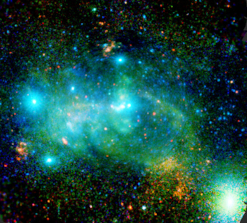Find out the latest thinking about our universe.
-
bystander
- Apathetic Retiree
- Posts: 21592
- Joined: Mon Aug 28, 2006 2:06 pm
- Location: Oklahoma
Post
by bystander » Mon Mar 20, 2023 4:37 pm
 X-raying the Heart of Our Galaxy
X-raying the Heart of Our Galaxy
In many ways our knowledge of other galaxies is much better than that of our own home galaxy, the Milky Way. Embedded as we are within the Galaxy, surrounding by
enormous clouds of obscuring dust, the shape of the Galaxy, its center, and our location within it were first
teased out by painstaking observations of stars and star clusters. But a fuller understanding of the Milky Way requires the ability to peer through the dust which lines the disk of the Galaxy, especially toward the center of the Milky Way. X-rays are particularly good at penetrating dust, so studies of the Milky Way by X-ray observatories like the
Einstein X-ray Observatory,
ROSAT,
Chandra,
XMM-Newton and
eROSITA have provided important information about the structure of the Milky Way. The image above shows a mosaic of X-ray images near the center of the Milky Way from the XMM-Newton X-ray observatory.
XMM-Newton is a large X-ray telescope, and is particularly good at revealing faint sources and structures. The XMM-Newton mosaic reveals X-ray emission from binary stars containing normal stars coupled with X-ray emitting neutron stars or black holes, along with emission from star clusters, supernova remnants, and bubbles and superbubbles produced by winds and explosions of massive stars. The image is color-coded: red indicates low-energy X-rays, green medium energy X-rays, and blue the highest-energy X-rays that XMM-Newton can detect. The center of the Milky Way is embedded in the diffuse, bright region at the center of the image - the domain of the Milky Way's monster black hole,
Sgr A*.
Know the quiet place within your heart and touch the rainbow of possibility; be
alive to the gentle breeze of communication, and please stop being such a jerk. — Garrison Keillor
-
bystander
- Apathetic Retiree
- Posts: 21592
- Joined: Mon Aug 28, 2006 2:06 pm
- Location: Oklahoma
Post
by bystander » Mon Mar 20, 2023 4:52 pm
The Tumultuous Heart of our Galaxy
ESA | Space Science | 2015 Aug 20
X-ray View of the Galactic Centre ~ Credit: ESA/XMM-Newton/G. Ponti et al
The bright, point-like sources that stand out across the image trace binary stellar systems in which one of the stars has reached the end of its life, evolving into a compact and dense object – a neutron star or black hole. Because of their high densities, these compact remnants devour mass from their companion star, heating the material up and causing it to shine brightly in X-rays.
The central region of our galaxy also contains young stars and stellar clusters, and some of these are visible as white or red sources sprinkled throughout the image, which spans about one thousand light-years. ...
The XMM–Newton View of the Central Degrees of the Milky Way ~ G. Ponti
et al
Know the quiet place within your heart and touch the rainbow of possibility; be
alive to the gentle breeze of communication, and please stop being such a jerk. — Garrison Keillor
 X-raying the Heart of Our Galaxy
X-raying the Heart of Our Galaxy